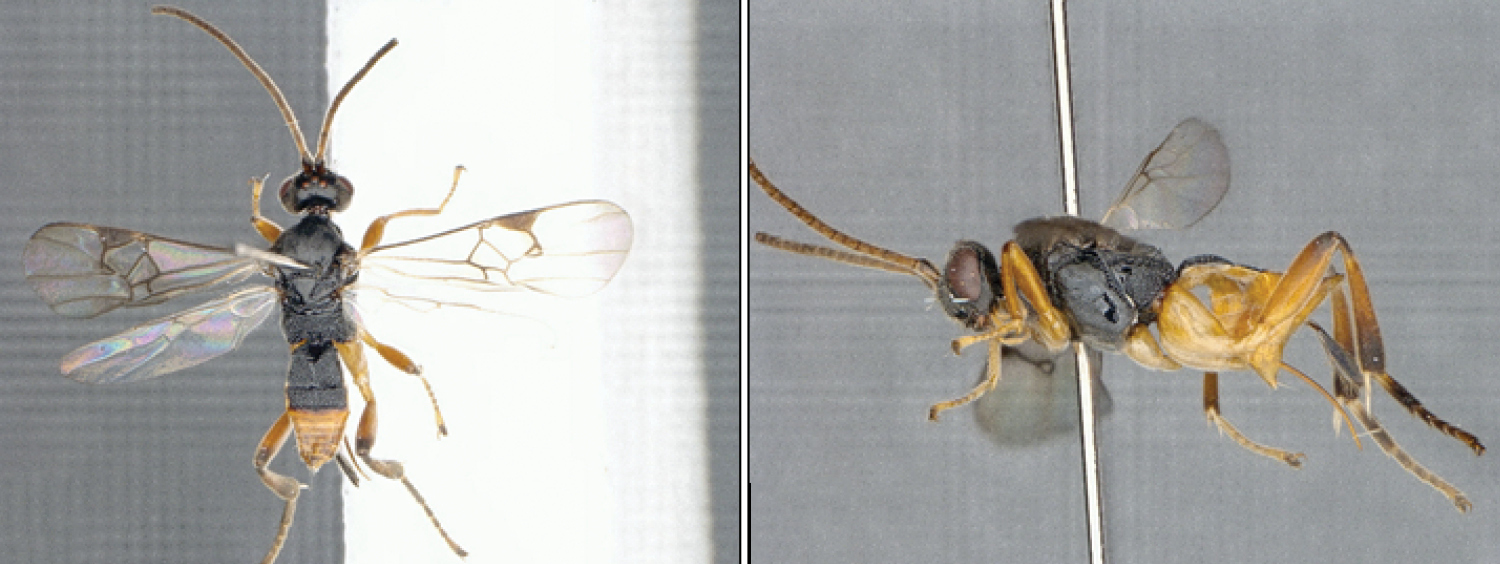Watch a 'Godzilla' wasp dominate Mothra in this eerie lab video

Delicate ferns lay across the still water, when suddenly, a writhing caterpillar bursts to the surface, followed closely by a determined wasp. Wrenching the caterpillar into position, the wasp quickly injects the wiggly creature with eggs before releasing it back into the water. Sound like the plot to a twisted sci-fi flick?
This parasitic wasp was recently discovered, in real life, in Japan and aptly named Microgaster godzilla, after the famous fictional monster. It is the first aquatic wasp to be caught on film while diving underwater to hunt down its host, namely, moth caterpillars called Elophila turbata.
"The wasp suddenly emerges from the water to parasitize the host, similar to how Godzilla suddenly emerges from the water in the movies," study author Jose Fernandez-Triana, a research scientist with the Canadian National Collection of Insects, said in a statement. In the movies, Godzilla also interacts with a monster called Mothra, who appears either as a caterpillar or full-grown moth. Since moth caterpillars serve as a host for M. godzilla eggs, "we had biological, behavioral and cultural reasons to justify our choice of a name," Fernandez-Triana said.
"Of course, that and having a bit of fun, because that is also an important part of life and science!" he added. Fernandez-Triana and his team described the newfound species in a study published Nov. 4 in the Journal of Hymenoptera Research.
Related: Ick! 5 alien parasites and their real-world counterparts
"Usually, taxonomic descriptions of parasitoid wasps are based on dead specimens, with very few details — often none — on its biology," Fernandez-Triana noted. In this study, the researchers had the rare opportunity to rear live wasps from larvae and observe exactly how they plant their eggs in unwary hosts.
To do so, the team scooped E. turbata caterpillars from ponds in the Osaka and Kyoto Prefectures of Japan. As mature wasps began to emerge from inside the collected caterpillars, the team spotted specimens with distinct yellow, brown and orange-yellow patterns on their bodies. They analyzed the morphology and DNA of these wasps and determined them to be a newfound species.
Sign up for the Live Science daily newsletter now
Get the world’s most fascinating discoveries delivered straight to your inbox.
To see the wasps in action, the team placed female M. godzilla specimens and their caterpillar hosts into aquariums and got the cameras rolling.

In the wild, E. turbata caterpillars encase their bodies in bits of vegetation and sit suspended just under the water's surface. In the lab video, an M. godzilla wasp can be seen feeling around for these homemade cases using its curved antennae. When it locates a caterpillar, the wasp slips beneath the water, staying down for several seconds, and wrestles the moth larvae out of its casing. The wasp then uses its enlarged, curved claws to grip and pull the grub to the surface, according to the study.
Related: Survival of the grossest: 8 disgusting animal behaviors
Holding the exposed caterpillar in place, the wasp inserts a tube-like organ called an ovipositor into the caterpillar’s body and sends its eggs down. "In all cases we observed, oviposition occurred above water, where the host larvae went trying to escape the wasp," the authors wrote. "The wasp can also pierce through the case for oviposition," when it's not fully removed, they added.
The wasps can sometimes force caterpillars out of their case without diving underwater, the authors noted. However, the wasp earned its monstrous name for the characteristic way it rises from the water after forcing its host into submission.
Originally published on Live Science.

Nicoletta Lanese is the health channel editor at Live Science and was previously a news editor and staff writer at the site. She holds a graduate certificate in science communication from UC Santa Cruz and degrees in neuroscience and dance from the University of Florida. Her work has appeared in The Scientist, Science News, the Mercury News, Mongabay and Stanford Medicine Magazine, among other outlets. Based in NYC, she also remains heavily involved in dance and performs in local choreographers' work.










